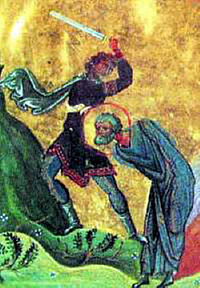Dasius of Durostorum
| Saint Dasius of Durostorum | |
|---|---|

Depiction of the execution of Dasius from the Menologion of Basil II (late 10th or early 11th century)
|
|
| Martyr | |
| Died | Durostorum |
| Feast | 20 November |
Dasius of Durostorum (Дазий Доростолски) is a Christian martyr of the early 4th century AD. He was a Roman soldier of Legio XI Claudiana at Durostorum (modern Silistra), Moesia Inferior who was beheaded in the early 4th century after his refusal to take the part of "king" in the local Saturnalia celebrations.
Dasius was the first of twelve martyrs executed at Durostorum during the Diocletianic Persecution. A Greek Passion of St. Dasius survives, also known as the Acta Dasii, dated to between the late 4th and late 6th centuries. This text was discovered in the 1890s by Franz Cumont in an 11th-century manuscript. Before Cumont's discovery, the saint had only been known from short entries in various medieval martyrologies.
The text of the Acta Dasii as it survives does not have an earlier date than the late 4th century, as Dasius is anachronistically depicted as professing the Neo-Nicene (Niceno–Constantinopolitan) creed as laid down in 381. Cumont himself dated the text to the 5th or 6th century, considering the possibility that this text was in turn based on an older, 4th-century Latin text, which would have been written within a few decades of the historical event. Cumont's assumptions are primarily based on linguistic considerations, especially on the numerous Latinisms in the Greek text. Cumont (1897) was of the opinion that much of the text reflects a historical event. A number of minor anachronisms were introduced when the Latin text was translated into Greek in the 5th or 6th century. There was a significant scholarly debate on the text during the years following Cumont's conclusions. Pillinger (1988:30) has also called into question some of Cumont's opinions in her more recent edition of the text.
The text purports to present a record of the questioning of Dasius by a legate called Bassus. In this dialogue, Dasius also refuses to honour the Imperial cult. The situation as described in the text thus presupposes the fourth Diocletian edict of 304, which required Roman soldiers to sacrifice to the emperor. Many veteran legionaries had been openly Christian during many years of service and now suddenly found themselves before the choice of either renouncing their religion or facing execution. After being questioned, Dasius is tortured and finally decapitated by one Johannes Aniketos. But hagiographical tradition tends to assign slightly earlier date to the martyrdom, either 302, 303 or 292. A parallel case is recorded in the passion of Julius the Veteran.
...
Wikipedia
